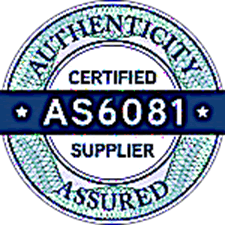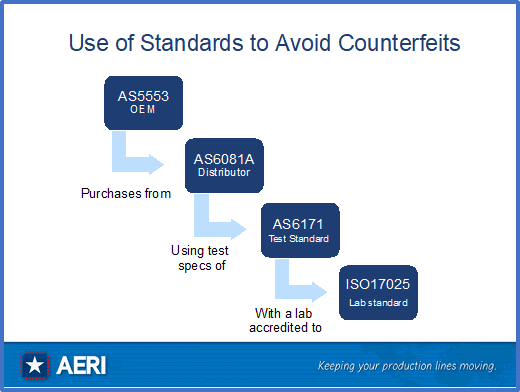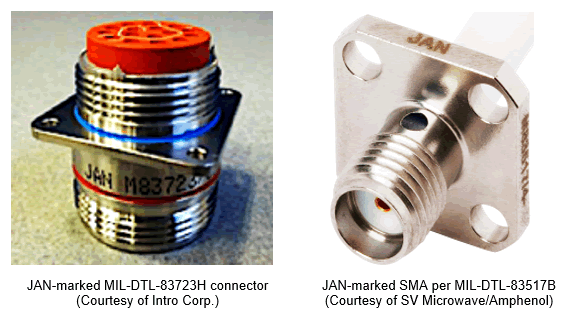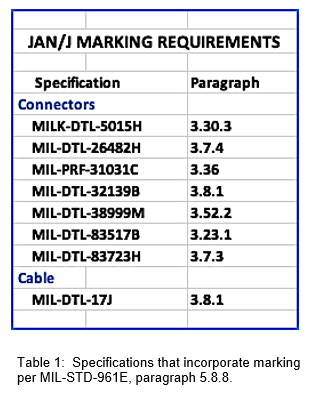Strike Counterfeit Mil-Spec Components From the Supply Chain
Special mil-spec marking, DNA tagging, and other advanced authentication technologies are helping to root out counterfeit connectors and cable.
 Are 40% of mil-spec connectors counterfeit? We’ve heard the statistic and it’s alarming — but not necessarily true. “The 40% is an average and varies wildly — from 15% to 85%,” based upon survey and program involved, said Jeremy Funk, senior electrical engineer with Defense Logistics Agency (DLA) Land and Sea (DSCC) at the 2018 RF Connector Conference. While much has been said about counterfeit consumer and semiconductor products, less glamorous electromechanical components, including connectors and cable, are compromised by fraudulent materials, platings, unsurveyed assembly sites, reused parts, and other non-conforming parameters that may be described as counterfeits. While a counterfeit consumer product may take work and profits away from an original manufacturer, the use of a counterfeit mil-spec connector or cable intended for a high-reliability or military/aerospace application can lead to equipment failure, potentially with life-affecting results. Can you trust your sources and the layers of international vendors that they use?
Are 40% of mil-spec connectors counterfeit? We’ve heard the statistic and it’s alarming — but not necessarily true. “The 40% is an average and varies wildly — from 15% to 85%,” based upon survey and program involved, said Jeremy Funk, senior electrical engineer with Defense Logistics Agency (DLA) Land and Sea (DSCC) at the 2018 RF Connector Conference. While much has been said about counterfeit consumer and semiconductor products, less glamorous electromechanical components, including connectors and cable, are compromised by fraudulent materials, platings, unsurveyed assembly sites, reused parts, and other non-conforming parameters that may be described as counterfeits. While a counterfeit consumer product may take work and profits away from an original manufacturer, the use of a counterfeit mil-spec connector or cable intended for a high-reliability or military/aerospace application can lead to equipment failure, potentially with life-affecting results. Can you trust your sources and the layers of international vendors that they use?
The Senate Armed Services Committee (SASC) reported in 2012 that US national security faced a significant threat from counterfeit electronics that have flooded the supply chains of defense contractors. They identified China as the dominant source of counterfeit electronic parts and the primary source for recycled scrap and surplus connectors. These products are often re-marked to newer or higher-level specifications before being resold. The Chinese government has failed to take steps to stop counterfeiting operations. The US Department of Defense (DoD), among other countries’ governments, lacks detailed knowledge of the scope and impact of counterfeit parts on critical defense systems.
However, the use of counterfeit mil-spec parts in defense systems can compromise performance, reliability, and safety of military personnel. Reliance on unvetted independent distributors and multi-level international supply chain vendors creates these unacceptable risks and weak testing programs for electronic and electromechanical parts open equipment to vulnerabilities. The defense industry routinely fails to report cases of suspect counterfeit parts.
Counterfeit parts have turned up almost everywhere, including US Missile Defense Agency mission computers, ship-based antenna arrays, helicopter night vision systems, and cables for missile systems. SASC reported that, in 2011, it had identified 1,800 cases of counterfeiting involving roughly one million parts.
In one example, recycled mil-spec connectors with cracked insulators were presented as meeting specification and required expensive removal, as they might have caused shorts between cavities or other electrical problems. Another problem arose when a US manufacturer shifted assembly for MIL-QPL connectors to a location that could not be audited by US DoD representatives. Manual assembly may have provided a cost savings, but insulator stack-ups were slightly misaligned. This product was probably good enough for most applications, but when they were used by a third-party assembler with multiport coaxes, the thin-walled coaxes could not be properly installed. The leading edges of the multiport coaxes caught on slightly offset hard plastic sections within the insulator. If installed, retention was suspect. Results could range from “opens” that might be found during test if one was lucky to changes in the RF signal under vibration that could affect mission performance.
Counterfeit generally means an unlawful or unauthorized reproduction, substitution, or alteration that has been knowingly mismarked, misidentified, or otherwise misrepresented to be an authentic, unmodified electronic part from the original manufacturer, or a source working under the authority of the original manufacturer or current design activity, including authorized distributors or aftermarket manufacturers. Unlawful or unauthorized substitution can range from approved vs. unauthorized sites, used electronic parts represented as new, or the false identification of grade, serial number, lot number, date code, or performance characteristics, and false materials can range from inaccurate claims of gold flash to 50μin gold plating minimums or similar. Some counterfeits also use gold falsely reported as not being from conflict areas, as defined by the SEC under the Dodd-Frank Wall Street Reform and Consumer Protection Act relating to the use of conflict minerals.
SAE Provides Critical Specifications for Avoiding Counterfeits
Much has been done by governments, industry, and companies to try to avoid counterfeit mil-spec components. The US government issued rules by the Defense Acquisition Regulations System concerning Detection and Avoidance of Counterfeit Electronic Parts (DFARS Case 2012-D055) effective May 6, 2014. This rule prompts companies to establish a Trusted Supplier List and encourages distributors to provide component traceability back to only authorized sources. Similar guidance standards have been published by organizations such as DIN, IEC, BSI, and SAE International (SAE).
SAE’s G-19 Counterfeit Electronic Components Committee has been in the forefront of developing systemic procedures to help prevent counterfeits from getting into our supply chain inventory, with publication of AS5553A, AS6081, AS6462A, and AS6301. A detailed recap of the important work by the G-19 committee can be found here.
Source: Presentation by Robb Hammond, President AERI and past Co-Chair of SAE’s G-19D counterfeit avoidance committee, which developed the AS6081 distributor counterfeit mitigation standard.

Source: Presentation by Robb Hammond, President AERI and past Co-Chair of SAE’s G-19D counterfeit avoidance committee, which developed the AS6081 distributor counterfeit mitigation standard.
Special Marking Validates Authentic Connectors
The DoD helps identify good vs. counterfeit products by using special markings that are registered trademarks of the US government and by adding DNA tags to cable, cable assemblies, and interconnect components.
Did you know that MS or mil-spec part numbers are not copyrighted or trademarked? Problems with the parts themselves may result in criminal action, but unethical marking, by itself, does not represent a punishable offense. To provide an alternate path to control counterfeit items, the US government has registered certification marking of “JAN” and “J” and is adding this marking requirement to many DoD/military specifications. When required, this marking is defined by MIL-STD-961E, paragraph 5.8.8. The following is a portion of the requirements proposed for inclusion in the forthcoming EIA-979 RF Transmission Line and Connector Selection Guide.
JAN and J Marking: The United States Government has adopted and is exercising legitimate control over the certification marks “JAN” and “J,” respectively, to indicate that items so marked or identified are manufactured to, and meet, all the requirements of specifications. Accordingly, items acquired to, and meeting, all of the criteria specified herein and in applicable specifications shall bear the certification mark “JAN” except that items too small to bear the certification mark “JAN” shall bear the letter “J.” The “JAN” or “J” shall be placed immediately before the part number. The United States Government has obtained Certificate of Registration Number 504,860 for the certification mark “JAN” and Registration Number 2,577,735 for the certification mark “J.”
The “JAN” or “J” is not part of the part number, but, rather, indicates a “certification.” Deliberately adding the JAN or J to counterfeit parts is basis for legal prosecution.

Many specifications have been updated to include requirements for JAN/J marking. The fundamental overall DoD standard for parts marking is MIL-STD-1285D, which redundantly describes JAN/J marking for items purchased under DoD specifications (para. 5.2.3). Specific requirements for many connectors and cable are shown in Table I below:

State-of-the-Art DNA Tags Support Counterfeit Detection
A truly state-of-the-art approach for detection of counterfeits is use of DNA tags. The Defense Logistics Agency (DLA) is basing this upon a program by the US Army Research Development and Engineering Command Edgewood Chemical Biological Center, in which organic DNA is rearranged into unique sequences that are encrypted and attached to components to identify authenticity. The DLA now has a mandate to mark components with DNA whenever possible. This could be applied to cable jackets, connector housings, or almost anywhere.
Inspection can be done by shining a light on the item to reveal a mark that confirms the existence of DNA. A quick swab of the mark can then be quickly analyzed to confirm whether the item is authentic. Any attempt to tamper with the component will distort or remove the DNA mark. A smudged or missing mark would immediately trigger an alert when it is inspected. Applied DNA Sciences Inc. recently reported that evidence using their SigNature DNA has resulted in over 131 convictions, with sentences totaling 625 years, and many more cases are currently pending.
Very few products don’t need to be electrically connected to something else. The sale and use of counterfeit connectors and cabling poses a major problem for the electronics industry, and especially for mil-spec applications. With new and establish techniques, government agencies and the electronics industry are working to prevent counterfeits from entering the supply chain.
Like this article? Check out our other Standards articles, our 2019 Article Archive, and our Military and Aerospace market page.
- New Circular Connectors Add to Multi-Billion Dollar Market - January 9, 2024
- Counterfeit Components Ground Airlines - December 12, 2023
- Cables, Connectors, Waveguides, and Hybrid Products for up to THz at IMS 2023 - July 11, 2023





